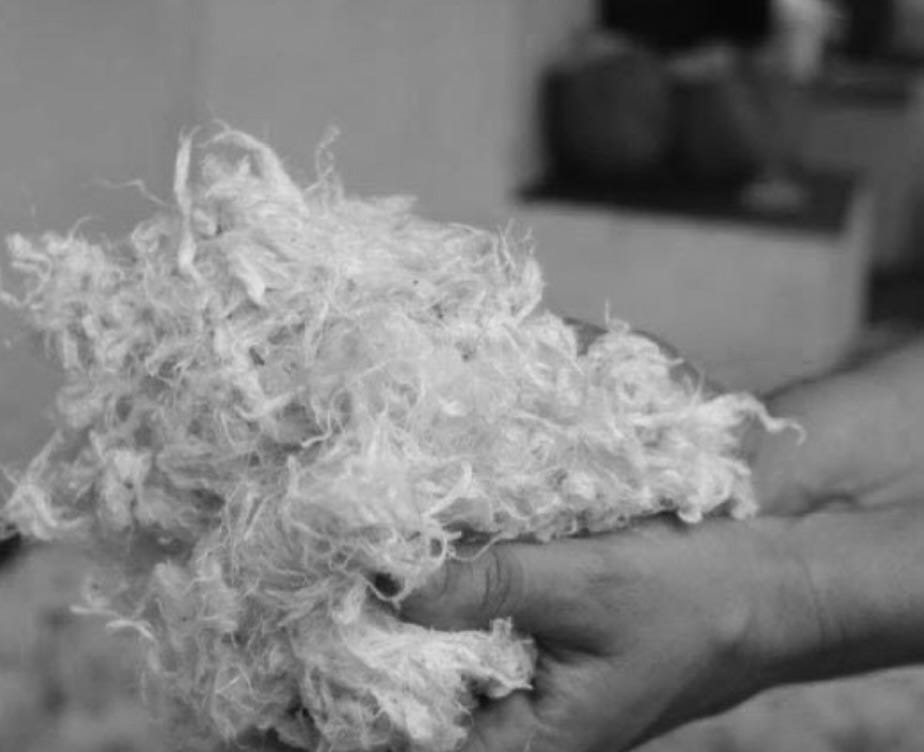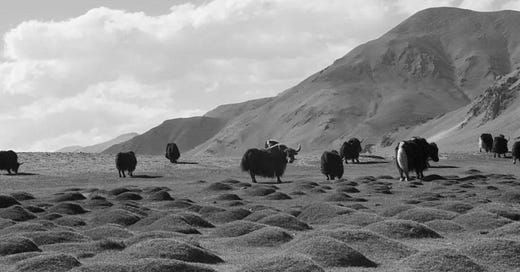The Biodiversity of Our Closets
There are a lot of really cool natural materials out there that could be used as fiber, but they can’t compete with the big commodity fibers
In early summer, nomads in Tibet gather their herd and harvest the yaks’ fiber. Like cashmere, yaks produce a fine undercoat to protect them from the cold in the winter and shed it in the summer. The herders comb out the yaks’ fiber before they can naturally shed their fine hairs, and use the fiber for clothing and shelter. Unlike cashmere, yak fiber has never been fully commodified. In certain parts of the Himalayas, yak fiber is ubiquitous, found in clothing, home textiles, and even as insulation for yurts. But you’ll be hard pressed to find a garment produced with yak fibers in a store in the US or Europe.

Today, 67% of what we wear is plastic, 20% of what we wear is cotton, 6% of what we wear is manmade cellulose fiber (rayon), 5% of what we wear is linen or hemp, 1% of what we wear is wool, 0.1% of what we wear is silk, and 0.04% of what we wear is other animal fiber (cashmere’s category). Although there are many different designs, we only wear a very short list of materials—a small fraction of all the materials and varieties that have the potential to be used for clothing.
As far as commercial products, we have only scraped the surface of what natural materials can clothe us. Material innovation right now is focused on finding new and creative ways to turn oil into clothing. But what if it were innovating or creating scalable systems for the diversity of fibers cast aside during the race to the bottom?

Milkweed is a perennial flowering plant native to North America. It is known for its crucial role in monarch butterflies – monarch caterpillars only feed on milkweed. In the spring, pods on the milkweed open, exposing white fibers attached to the seed. The fiber is lightweight, buoyant, and insulating. It is great for garment insulation; in fact, the US military used it in World War II to fill life vests. Despite its potential as a fiber, ease of growth, ecosystem service to monarchs, and ability to be a non-plastic and vegan alternative to down, milkweed is rarely used as a fiber.
White nettle has a similar story. It grows rapidly and prolifically and requires little input to thrive. The stocks of nettle contain a fiber similar to linen. Once retted, spun, and woven, nettle fiber creates a breathable, sturdy fabric called ramie. Although ramie is available for commercial fabrics, it is very much eclipsed by the more popular bast fibers of linen and hemp.
Yak, milkweed, and ramie are all available as commercial goods, albeit a very small relative quantities compared to the popular natural fibers. Many traditional natural fibers never came close to commodification.

South America is home to a handful of native camelids. Of the South American camelid, Alpacas are most well-known for their fiber. Alpacas are domesticated Vicunas, a wild grazer that roams the high grasslands of Peru. The ancestors of today's alpaqueros would corral herds of vicuna once a year and shear them for their fiber needs. Slowly, they figured out how to keep them nearby and breed them for advantageous characteristics, resulting in herds of fiber-producing alpacas. Peru’s neighbor to the South is home to a different camelid. Guanaco's native grazing zone is Argentina and Chile’s Patagonia region. They share a lot of characteristics with vicunas and definitely have the potential for domestication to an alpaca-like fiber producer. But that never happened. Instead, colonists shipped in merino sheep from Europe. Guanaco’s native grazing land is now populated with foreign roamers that are over-grazing and altering the native ecosystem balance.
There is some level of survival of the fittest when it comes to which fibers won out as a major commodity versus which were left by the wayside. But there are so many other factors that create a commodity fiber. Cotton is truly an amazing fiber: it has a diversity of uses, it’s able to grow in a ton of regions, and it is easy to produce into cloth. But a through-line in cotton’s history, up until today, is its dependence on slavery. It has also benefited from subsidies, economies of scale, and extensive marketing campaigns. It’s not the best and most prolific simply because it's the best and most prolific. A perfect combination of environmental, social, political, and economic forces supported its rise to the top.
The current over-dependence on a short list of fibers is causing strain on our current resources. For example, conventionally growing cotton is diminishing topsoil, and overproduction of cashmere goats is desertifying the Mongolian steppe. Increasing biodiversity creates resilience. Renewable material innovation to diversify the nature of represented in our closets and growing on our farms and pastures is the future of a resilient fashion production.
Quick note: When I talk about diversifying natural fiber, I mean fibers, not inputs for manmade cellulose materials. Inputs like soy, bamboo, milk, eucalyptus, and other wood are used as the carbon-rich starting point of viscose material. Making viscose is a process of using intensive chemicals to break down woody material to a pulp, regenerate the cellulosic strands using acids, and form them into a fiber for spinning. The result is a semi-synthetic material.
Read further on diversifying our closets:
We’re All Wearing the Same Thing
Almanacs are resources to understand how natural cycles interact with specific topics. Everything we wear comes from the Earth and is a part of natural cycles. Each month, The Mindful Designer’s Almanac offers musings about natural fibers harvested that month or season.
Notes
https://fashionista.com/2020/01/future-sustainable-fashion-materials-milkweed-floss
https://textileexchange.org/app/uploads/2024/09/Materials-Market-Report-2024.pdf






Very interesting. Let's start a milkweed farm!
So interesting, as ever, thanks! I have knitted a few pairs of socks with Onion’s nettle-blend yarn and that’s been really nice (unfortunately the blend is with super wash: https://idashouse.co.uk/products/onion-nettle-sock-yarn) so would love more innovative use of different fibres. Do you know the film The Nettle Dress? Very moving: https://www.nettledress.org/
I’d back a milkweed farm (lovely name) :)